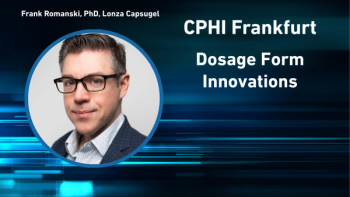
PTSM: Pharmaceutical Technology Sourcing and Management
- PTSM: Pharmaceutical Technology Sourcing and Management-11-07-2012
- Volume 8
- Issue 11
Seeking Solutions in Solid-State Chemistry
Particle-engineering technologies, such as crystal design for crystallization and producting cocrystals, particle-size reduction, and amorphous solid dispersions, help to optimize delivery of a drug.
The physical form of an API is important in formulation developmentfor resolving issues in bioavailability and solubility. Particle-engineeringtechnologies can be applied in various ways: crystal design for controllingcrystallization and producing cocrystals; particle-size reduction, achievedthrough jet-milling, wet polishing and nanoparticle generation; and amorphoussolid dispersions, produced by several approaches, such as spray-drying(including as inclusion complexes), hot-melt extrusion (HME), andspray-congealing. Pharmaceutical Technology discussed theseissues with Colin Minchom, vice president, of the Particle Design Business Unitat Hovione.
Patricia Van Arnum
Crystallization
PharmTech: Under what type of situations would crystallization be used? How does itfacilitate the delivery of poorly soluble drugs?
Minchom: Interest in cocrystals has increased in recent years, and the recent FDAguidance on a proposed classification of cocrystals has prompted furtherdiscussion and counter proposals from the industry. The proposed US FDAclassification of cocrystals as crystalline materials containing two or moremolecules in the same crystal lattice is limited but can serve as a startingpoint for discussion.
IMAGES ETC LTD/GETTY IMAGES
The addition of a cocrystal former into the crystalline structure ofthe API changes its physical and chemical properties. It is possible, in somecases, to improve bioavailability to adequate levels while preserving thestability of a crystalline form. For APIs with low glass-transition temperatures,a cocrystal may be favoured over the amorphous form. As such, the use of acocrystal may be an attractive platform to overcome the solubility limitations ofBiopharmaceutics Classification System Class II and Class IV drugs.
Cocrystal formation is a favored approach for increasing apparentaqueous solubility for poorly water-soluble molecules that have no ionizablegroups, and for which salt formation is not possible, or for where the physicalproperties of the salts formed are not desirable. Solvates and hydrates arewell-accepted crystal forms. In many ways, a cocrystal can be thought of as asolvate, but one whose components are solid at room temperature. The cocrystalwill form if the resulting crystal is thermodynamically more stable than thecomponents. Resulting cocrystal properties are dependent upon many factors,including the starting properties of the API, the physical properties of theco-former and the mechanism by which the cocrystal is formed. To increase theprobability of success, we [Hovione] recommend that at early-development stagesto test other proven platforms, such as solid dispersions, micronized andnanosized crystals and inclusion complexes.
Applying acoustic levitation for elucidation of amorphous material
PharmTech: Controlling nucleation during crystallization is an important task. Whatare the mechanisms for controlling crystallization?
Minchom: Where milling techniques can be thought of as top-down sizingtechniques, controlled crystallization is where the desired particle-sizedistribution is achieved from the bottom up. The objectives of a crystallizationprocess are twofold. On the one hand, the aim is to isolate the API in the rightcrystal form, typically a polymorph that provides the required level of exposureand stability. On the other hand, crystallization may also be a purificationstage, whereby the impurities remain mostly dissolved in the mother liquors.
The kinetics of crystallization (nucleation and crystal growth rates)are driven by the imposed supersaturation levels. The degree of supersaturation,temperature ramp, mixing, filtration and final drying process all contribute tothe final particle-size distribution. Moreover, the relative importance of eachfactor can change at each scale.
Particle-size reduction
PharmTech:What factors determine particle size? What are the differences inparticle size achieved through jet-milling, wet polishing, and nanoparticlegeneration?
Minchom: Particle-size reduction is not a simple phenomenon. The mechanism ofgenerating the material of the prescribed particle size has a profound effectupon a range of physical properties that may have a significant effect on theresulting pharmaceutical behavior. The final particle size of a materialsubjected to a comminution process is dictated by particle attributes, such ascrystal hardness, morphology, and original crystal size, as well as thesize-reduction method and energy applied. Jet-milling and wet polishing maygenerate materials with equivalent median particle sizes; however, the resultingspan from jet-milled material is likely to be wider than the wet-polishedmaterial. Amorphous material and highly reactive surfaces also may result fromjet-milling while a higher level of crystallinity is maintained with wetpolishing.
Dry methods, such as jet-milling, tend to be more cost-effective(mainly because they do not require sophisticated isolating techniques), but theyare more aggressive, less reproducible, and more limited in terms of theachievable size reduction.
Amorphous solid dispersions
PharmTech: What factors determine which method (i.e., spray-drying, HME,spray-congealing, and inclusion-complex generation) to use to produce theamorphous solid dispersion?
Minchom: Amorphous solid dispersions represent a tremendous opportunity forsolubility enhancement of oral drugs. The resulting supersaturation levels (andhence bioavailability) and the physical stability of the final dosage form,however, depend on the manufacturing method applied. Many approaches areavailable to generate amorphous solid dispersions.
Spray-drying, being a solvent method, is the most versatile techniqueto obtain solid dispersions due to its gentle process conditions and much widerformulation options. Spray-drying is a technology that works well in nearly everycompound. Another advantage of spray-drying is that it can be effectivelyoperated using much smaller quantities of drug substance, thereby making it themost cost-effective option during early-stage development.
Melt methods, such as HME and spray-congealing, on the other hand,are more cost effective at the larger scale manufacturing and have the additionaladvantage of being solvent-free techniques. To use these methods, however, thecompound needs to be soluble in the polymer/matrix and physically stablecomplexes need to be created. These methods are also limited to drug substancesthat can sustain relatively high heat loads. All these techniques are relativelywell-established within the pharmaceutical industry, although spray-drying is astep ahead in terms of maturity.
Although challenging at a very small scale, the rationale design ofan HME formulation is viable when the API is available in pilot-scale quantities.Where an API has low solubility in all preferred spray-drying solvents or retainsextensive solvent following drying, HME may represent the best way forward forthe development of a stable amorphous solid dispersion. Spray-congealing can usesa number of lipophilic excipients, which are useful in formulating poorlywater-soluble compounds that will form self emulsifying drug-delivery systems(SEDD) or self micro-emulsifying drug-delivery systems (SMEDDS) onadministration, as well as the polymers commonly used in spray-dried amorphoussolid dispersions.
Patricia Van Arnum is executive editor of PharmaceuticalTechnology, 485 Route One South, Bldg F, First Floor, Iselin, NJ 08830tel. 732.346.3072,
Articles in this issue
about 13 years ago
Sizing the Market for Contract Manufacturingabout 13 years ago
Contract Manufacturers and Fine-Chemicals Producers Expandabout 13 years ago
CSR and Sustainability in the Newsabout 13 years ago
Mixed Reviews for Biotechnology FinancingNewsletter
Get the essential updates shaping the future of pharma manufacturing and compliance—subscribe today to Pharmaceutical Technology and never miss a breakthrough.




